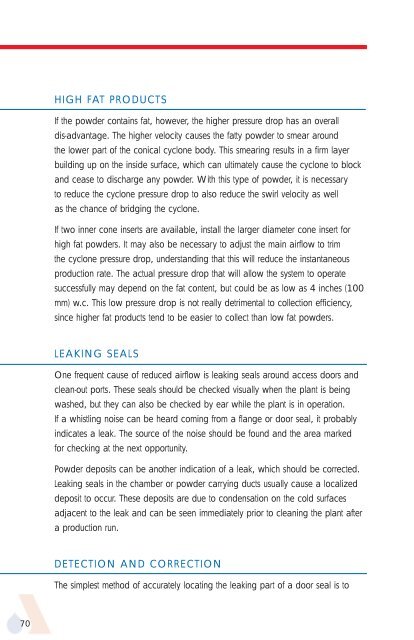APV Dryer Handbook - Umbc
APV Dryer Handbook - Umbc
APV Dryer Handbook - Umbc
You also want an ePaper? Increase the reach of your titles
YUMPU automatically turns print PDFs into web optimized ePapers that Google loves.
70<br />
HIGH FAT PRODUCTS<br />
If the powder contains fat, however, the higher pressure drop has an overall<br />
dis-advantage. The higher velocity causes the fatty powder to smear around<br />
the lower part of the conical cyclone body. This smearing results in a firm layer<br />
building up on the inside surface, which can ultimately cause the cyclone to block<br />
and cease to discharge any powder. With this type of powder, it is necessary<br />
to reduce the cyclone pressure drop to also reduce the swirl velocity as well<br />
as the chance of bridging the cyclone.<br />
If two inner cone inserts are available, install the larger diameter cone insert for<br />
high fat powders. It may also be necessary to adjust the main airflow to trim<br />
the cyclone pressure drop, understanding that this will reduce the instantaneous<br />
production rate. The actual pressure drop that will allow the system to operate<br />
successfully may depend on the fat content, but could be as low as 4 inches (100<br />
mm) w.c. This low pressure drop is not really detrimental to collection efficiency,<br />
since higher fat products tend to be easier to collect than low fat powders.<br />
LEAKING SEALS<br />
One frequent cause of reduced airflow is leaking seals around access doors and<br />
clean-out ports. These seals should be checked visually when the plant is being<br />
washed, but they can also be checked by ear while the plant is in operation.<br />
If a whistling noise can be heard coming from a flange or door seal, it probably<br />
indicates a leak. The source of the noise should be found and the area marked<br />
for checking at the next opportunity.<br />
Powder deposits can be another indication of a leak, which should be corrected.<br />
Leaking seals in the chamber or powder carrying ducts usually cause a localized<br />
deposit to occur. These deposits are due to condensation on the cold surfaces<br />
adjacent to the leak and can be seen immediately prior to cleaning the plant after<br />
a production run.<br />
DETECTION AND CORRECTION<br />
The simplest method of accurately locating the leaking part of a door seal is to











